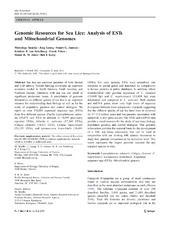| dc.contributor.author | Yasuike, Motoshige | eng |
| dc.contributor.author | Leong, Jong | eng |
| dc.contributor.author | Jantzen, Stuart G. | eng |
| dc.contributor.author | Schalburg, Kristian R. von | eng |
| dc.contributor.author | Nilsen, Frank | eng |
| dc.contributor.author | Jones, Simon R. M. | eng |
| dc.contributor.author | Koop, Ben F. | eng |
| dc.date.accessioned | 2012-02-29T13:54:39Z | |
| dc.date.available | 2012-02-29T13:54:39Z | |
| dc.date.issued | 2011-07-12 | eng |
| dc.identifier.issn | 0301-4851 | en_US |
| dc.identifier.uri | http://hdl.handle.net/1956/5670 | |
| dc.description.abstract | Sea lice are common parasites of both farmed and wild salmon. Salmon farming constitutes an important economic market in North America, South America, and Northern Europe. Infections with sea lice can result in significant production losses. A compilation of genomic information on different genera of sea lice is an important resource for understanding their biology as well as for the study of population genetics and control strategies. We report on over 150,000 expressed sequence tags (ESTs) from five different species (Pacific Lepeophtheirus salmonis (49,672 new ESTs in addition to 14,994 previously reported ESTs), Atlantic L. salmonis (57,349 ESTs), Caligus clemensi (14,821 ESTs), Caligus rogercresseyi (32,135 ESTs), and Lernaeocera branchialis (16,441 ESTs)). For each species, ESTs were assembled into complete or partial genes and annotated by comparisons to known proteins in public databases. In addition, whole mitochondrial (mt) genome sequences of C. clemensi (13,440 bp) and C. rogercresseyi (13,468 bp) were determined and compared to L. salmonis. Both nuclear and mtDNA genes show very high levels of sequence divergence between these ectoparastic copepods suggesting that the different species of sea lice have been in existence for 37–113 million years and that parasitic association with salmonids is also quite ancient. Our ESTs and mtDNA data provide a novel resource for the study of sea louse biology, population genetics, and control strategies. This genomic information provides the material basis for the development of a 38K sea louse microarray that can be used in conjunction with our existing 44K salmon microarray to study host–parasite interactions at the molecular level. This report represents the largest genomic resource for any copepod species to date. | en_US |
| dc.language.iso | eng | eng |
| dc.publisher | Springer | en_US |
| dc.rights | Creative Commons Attribution Noncommercial License | |
| dc.rights.uri | https://creativecommons.org/licenses/by-nc/2.0 | eng |
| dc.subject | Lepeophtheirus salmonis | eng |
| dc.subject | Caligus clemensi | eng |
| dc.subject | C. rogercresseyi | eng |
| dc.subject | Lernaeocera branchialis | eng |
| dc.subject | Mitochondrial genome | eng |
| dc.subject | Expressed sequence tags | eng |
| dc.title | Genomic Resources for Sea Lice: Analysis of ESTs and Mitochondrial Genomes | en_US |
| dc.type | Peer reviewed | |
| dc.type | Journal article | |
| dc.description.version | publishedVersion | en_US |
| dc.rights.holder | Copyright the Author(s) 2011 | en_US |
| dc.identifier.doi | https://doi.org/10.1007/s10126-011-9398-z | |
| dc.identifier.cristin | 959521 | |
| dc.source.journal | Molecular Biology Reports | |
| dc.source.pagenumber | 155-166 | |
| dc.subject.nsi | VDP::Mathematics and natural science: 400::Zoology and botany: 480::Marine biology: 497 | en_US |
| dc.subject.nsi | VDP::Agriculture and fishery disciplines: 900::Fisheries science: 920 | en_US |
| dc.identifier.citation | Molecular Biology Reports 14(2): 155-166 | |
| dc.source.volume | 14 | |
| dc.source.issue | 2 | |

